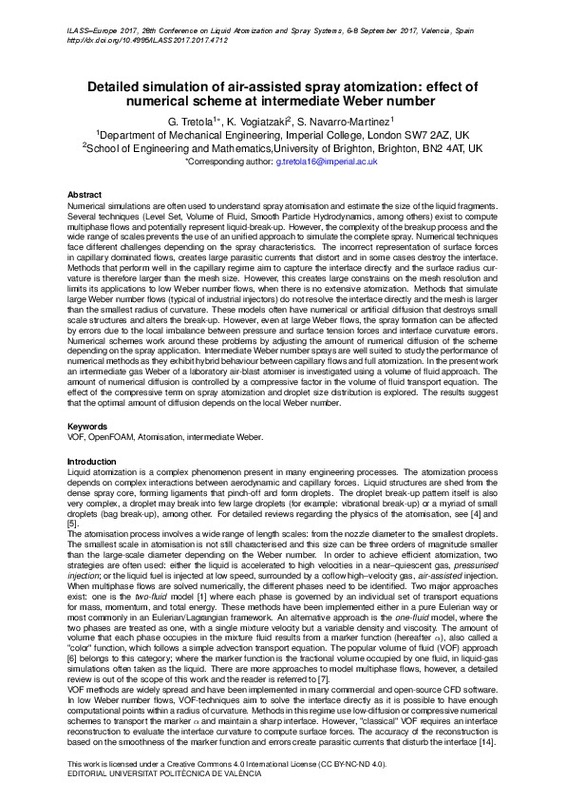JavaScript is disabled for your browser. Some features of this site may not work without it.
Buscar en RiuNet
Listar
Mi cuenta
Estadísticas
Ayuda RiuNet
Admin. UPV
Detailed simulation of air-assisted spray atomization: effect of numerical scheme at intermediate Weber number
Mostrar el registro sencillo del ítem
Ficheros en el ítem
| dc.contributor.author | Tretola, Giovanni
|
es_ES |
| dc.contributor.author | Vogiatzaki, Konstantina
|
es_ES |
| dc.contributor.author | Navarro-Martinez, Salvador
|
es_ES |
| dc.date.accessioned | 2018-04-12T10:54:03Z | |
| dc.date.available | 2018-04-12T10:54:03Z | |
| dc.date.issued | 2017-07-28 | |
| dc.identifier.isbn | 9788490485804 | |
| dc.identifier.uri | http://hdl.handle.net/10251/100293 | |
| dc.description.abstract | [EN] Numerical simulations are often used to understand spray atomisation and estimate the size of the liquid fragments. Several techniques (Level Set, Volume of Fluid, Smooth Particle Hydrodynamics, among others) exist to compute multiphase flows and potentially represent liquid-break-up. However, the complexity of the breakup process and the wide range of scales prevents the use of an unified approach to simulate the complete spray. Numerical techniques face different challenges depending on the spray characteristics. The incorrect representation of surface forces in capillary dominated flows, creates large parasitic currents that distort and in some cases destroy the interface. Methods that perform well in the capillary regime aim to capture the interface directly and the surface radius curvature is therefore larger than the mesh size. However, this creates large constrains on the mesh resolution and limits its applications to low Weber number flows, when there is no extensive atomization. Methods that simulate large Weber number flows (typical of industrial injectors) do not resolve the interface directly and the mesh is larger than the smallest radius of curvature. These models often have numerical or artificial diffusion that destroys small scale structures and alters the break-up. However, even at large Weber flows, the spray formation can be affected by errors due to the local imbalance between pressure and surface tension forces and interface curvature errors. Numerical schemes work around these problems by adjusting the amount of numerical diffusion of the scheme depending on the spray application. Intermediate Weber number sprays are well suited to study the performance of numerical methods as they exhibit hybrid behaviour between capillary flows and full atomization. In the present work an intermediate gas Weber of a laboratory air-blast atomiser is investigated using a volume of fluid approach. The amount of numerical diffusion is controlled by a compressive factor in the volume of fluid transport equation. The effect of the compressive term on spray atomization and droplet size distribution is explored. The results suggest that the optimal amount of diffusion depends on the local Weber number. | es_ES |
| dc.description.sponsorship | This work is part of the HAoS project, which is supported by the EU as part of the Horizon 2020 program. | es_ES |
| dc.format.extent | 8 | es_ES |
| dc.language | Inglés | es_ES |
| dc.publisher | Editorial Universitat Politècnica de València | es_ES |
| dc.relation.ispartof | Ilass Europe. 28th european conference on Liquid Atomization and Spray Systems | es_ES |
| dc.rights | Reconocimiento - No comercial - Sin obra derivada (by-nc-nd) | es_ES |
| dc.subject | VOF | es_ES |
| dc.subject | OpenFOAM | es_ES |
| dc.subject | Atomisation | es_ES |
| dc.subject | Intermediate Weber | es_ES |
| dc.title | Detailed simulation of air-assisted spray atomization: effect of numerical scheme at intermediate Weber number | es_ES |
| dc.type | Capítulo de libro | es_ES |
| dc.type | Comunicación en congreso | es_ES |
| dc.identifier.doi | 10.4995/ILASS2017.2017.4712 | |
| dc.relation.projectID | info:eu-repo/grantAgreement/EC/H2020/675676/EU/Holistic Approach of Spray Injection through a Generalized Multi-phase Framework/ | es_ES |
| dc.rights.accessRights | Abierto | es_ES |
| dc.description.bibliographicCitation | Tretola, G.; Vogiatzaki, K.; Navarro-Martinez, S. (2017). Detailed simulation of air-assisted spray atomization: effect of numerical scheme at intermediate Weber number. En Ilass Europe. 28th european conference on Liquid Atomization and Spray Systems. Editorial Universitat Politècnica de València. 249-256. https://doi.org/10.4995/ILASS2017.2017.4712 | es_ES |
| dc.description.accrualMethod | OCS | es_ES |
| dc.relation.conferencename | ILASS2017 - 28th European Conference on Liquid Atomization and Spray Systems | es_ES |
| dc.relation.conferencedate | September 06-08,2017 | es_ES |
| dc.relation.conferenceplace | Valencia, Spain | es_ES |
| dc.relation.publisherversion | http://ocs.editorial.upv.es/index.php/ILASS/ILASS2017/paper/view/4712 | es_ES |
| dc.description.upvformatpinicio | 249 | es_ES |
| dc.description.upvformatpfin | 256 | es_ES |
| dc.type.version | info:eu-repo/semantics/publishedVersion | es_ES |
| dc.relation.pasarela | OCS\4712 | es_ES |
| dc.contributor.funder | European Commission | es_ES |








